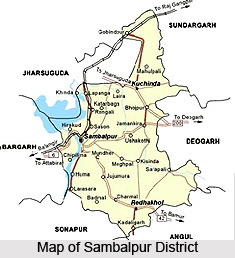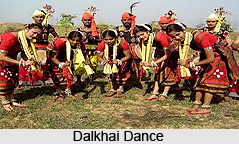 Sambalpur District is the westernmost district of Orissa and it had been named after the headquarters town, Sambalpur. According to historical records, the town derived its name from the presiding goddess Samalai, whose stone image was discovered by Balaram Dev, the first Chauhan king of Sambalpur.
Sambalpur District is the westernmost district of Orissa and it had been named after the headquarters town, Sambalpur. According to historical records, the town derived its name from the presiding goddess Samalai, whose stone image was discovered by Balaram Dev, the first Chauhan king of Sambalpur.
Location of Sambalpur District
Sambalpur District lies between 20 degree 40 minutes north and 22 degree 11 minutes north latitude and 82 degree 39 minutes east and 85 degree 15 minutes east longitude with a total area of 6,702 sq kms. The district is surrounded by Deogarh District in the east, Bargarh District and Jharsuguda district in the west, Sundargarh District in the north and Subarnapur District and Angul district in the south.
History of Sambalpur District
Sambalpur District has a history full of events including its role in the freedom struggle of the country. History of Sambalpur states that Samudragupta in 4th century defeated King Mahendra of Koshala, the kingdom that included Sambalpur. During the 5th and 6th centuries Sambalpur came under the rule of Sarbhapuriyas. In 7th century it passed in to the hands of Panduvansi king Trivaradeva. Further, towards the close of 9th century king Janmajaya I Mahabhavagupta extended his empire which comprised Sambalpur District and Balangir District. Hence forward, his dynasty came to be known as Somvanshi dynasty. During the last part of the Somvanshi rule, Sambalpur was occupied by the Kalachuris of Ratnapua. 13th century saw a bitter fight between the Kalachuris and the Gandas. Later on, the Gandas occupied Sambalpur. During the mid 14th century Ramai Dev laid the foundation of the Chauhan rule in Western Orissa. However, the Chauhan rule ended in April, 1800, when Sambalpur was occupied by the Marathas. Sambalpur was occupied by the British on 2nd January, 1804. Finally it passed on to the Brithish in 1817. The subsequent years witnessed the movements of the Kandhas and Binjhal Zamidars against the British. The erstwhile Sambalpur District was divided into four districts namely Sambalpur, Bargarh, Jharsuguda and Deogarh on 31st March, 1993. Jharsuguda District and Deogarh District started functioning on 1st of January, 1994. The important historical relics in the district of Sambalpur are the temples built by the Chauhan rulers.
Geography of Sambalpur District
Sambalpur District has three distinctive physiographic units such as, hilly terrain of Bamra and Kuchinda in the north, plateau and ridges of Rairakhol in the south-east and valley and plains of Sambalpur sub-division in the south east. This district experiences extreme type of climate with hot and dry summer followed by humid monsoon and severely cold winter. The hot season commences from 1st week of March and lasts till the second half of June. Sambalpur district experiences 66 rainy days and 153 centimeters rainfall on an average per annum. Most of the rainfall is confined to the months from June to October visited by south west monsoon. Mercury increases up to 47 degree Celsius during May with intolerable heat wave and falls as low as 11 degree Celsius during December with extreme cold.
 The rainfall is highly uneven and irregular. After rainy season the humidity gradually decreases and the weather becomes dry towards the winter. Sambalpur District forms a part of the Mahanadi River basin. The Mahanadi, the longest river of the state, enters into the district in the north western border, where the famous Hirakud Multipurpose Dam Project is built. Other important rivers of the district are the Maltijor, the Harrad, the Kulsara, the Bheden, and the Phuljharan. The district has a total forest area of 3986.27 sq kms which is around 59.46 percent of the total area of the district. Total land under cultivation in the district is 173540 hectares. Most of the villages of the district are inaccessible during the rainy season. Sambalpur district forms a part of North-West upland of Orissa, which is rolling and multiplying the ground slopes from a height of 776 feet to a height of 460 feet. The district has regur soil.
The rainfall is highly uneven and irregular. After rainy season the humidity gradually decreases and the weather becomes dry towards the winter. Sambalpur District forms a part of the Mahanadi River basin. The Mahanadi, the longest river of the state, enters into the district in the north western border, where the famous Hirakud Multipurpose Dam Project is built. Other important rivers of the district are the Maltijor, the Harrad, the Kulsara, the Bheden, and the Phuljharan. The district has a total forest area of 3986.27 sq kms which is around 59.46 percent of the total area of the district. Total land under cultivation in the district is 173540 hectares. Most of the villages of the district are inaccessible during the rainy season. Sambalpur district forms a part of North-West upland of Orissa, which is rolling and multiplying the ground slopes from a height of 776 feet to a height of 460 feet. The district has regur soil.
Culture of Sambalpur District
Culture of Sambalpur District is influenced by the customs and lifestyle of the tribal people. Tribals in Sambalpur District constitute 35.08 percent of the total population of the state. There are two types of tribal groups in the district scattered in nine Community Development Blocks. Mundari group includes tribes like the Kisans, the Orams, the Mirdhas, the Hos, the Mundas and the Kharias. The tribes like the Gonds, the Khanda, the Binjhal, and the Kudas come under the Dravidian Groups. Most of the community dances of the district are connected with worship of a deity. Colourful folk dances form an integral part of the culture of Sambalpur District. Dalkhai Dance, Karma Dance, Humo and Bauli, Koisabadi Dance are some of the popular folk dances of this district of Orissa. The folk instruments which are in vogue in Sambalpur Region are Dhole, Madal, Nishan, Tasa, Pakhoj, Bansi, Bir-Kahali, Gini, Ektara, Muhuri, Ghulgula, Ghunguru, Jhanj, etc. Oriya language is the principal language of the district. The language spoken in Sambalpur differs from that spoken in the costal districts of Orissa. It is generally known as Sambalpuri and is spoken in western part of Orissa. The architecture in the district attracts the people of all over world because of its unique designs.
Tourism in Sambalpur District
Sambalpur serves as the gateway to the bewitching western zone of Orissa, abounding in lush green forests, colorful wild-life, exquisite array of hills, waterfalls of streaming pearls, rich tribal life and culture, folk songs and dances and a variety of monuments. Nature has been bounteous to Sambalpur in more than one way. The wide diversity of flora and fauna in and around Sambalpur is an eloquent testimony attracts travellers from far and wide. There are many places of interest. Here, one can visit the temples of Samaleswari, Patneswari, Budha Raja, Brahmapura and the Gopaljee monastery. One of the longest dams in the world, Hirakud Dam stands in its lone majesty across the great river Mahanadi. Ushakothi Wildlife Sanctuary is the famed wildlife sanctuary at Badrama and it has already gained prominence among the tourists. Chiplima is the place that has gained prominence as the second Hydro-Electric Project of the Hirakud Dam. Other attractions are Nrusimhanath and Huma (famous as the abode of Lord Shiva, Huma contains the lone leaning temple of Orissa and also famous as a scenic spot of great excellence). Vikramkhol and Pradhanpat hill with its picturesque waterfalls offers a rare scenic beauty. All these places are worth seeing.
Sambalpur District is served by National Highway No.6, National Highway No.42 and by major district roads and a section of South Eastern Railways making it accessible from all parts of the country.






